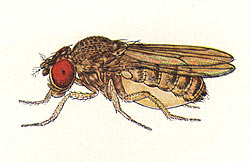Berkeleyan
Three bacterial genomes found lurking inside fruit-fly genomes
![]()
| 02 March 2005
 Drosophila mojavensis, a fruit-fly species within whose genome researchers discovered DNA from the previously unknown bacterium Wolbachia wMoj. (Courtesy the Flybase Consortium) |
The genes of these bacteria, from a genus (Wolbachia) that infects many insects, have been sitting in the fruit-fly gene database since then, unnoticed, according to Michael Eisen, assistant professor of molecular and cell biology and a faculty scientist at Lawrence Berkeley National Laboratory. But Eisen, a geneticist who mines the fruit-fly and other genomes for clues to how genes shape the organism, had an inkling they were there and, in a quick search of the genome database late last year, turned up a slew of bacterial genes.
Because he's a fruit-fly geneticist and not an expert on bacteria, Eisen contacted bacterial geneticists at The Institute for Genomic Research (TIGR) in Maryland, and together they pulled out genes from three species of Wolbachia - all of them new to science.
"The sequencers who did the Drosophila species didn't even notice this, because this is just a very small fraction of the total sequence and it was sort of tossed into the garbage," he said. "In every genome there is always stuff that doesn't make sense, and people weren't looking for it. We thought this was interesting as much for the novelty of the way the bacterial genomes were sequenced as for what we learned about the bacteria themselves."
A team led by Steven L. Salzberg of TIGR (which included Eisen) published its discovery in the most recent issue of the open-access journal Genome Biology. Eisen, a member of the California Institute for Quantitative Biomedical Research (QB3) at Berkeley, is a vocal advocate of open-access publishing, which makes the results of all research and research data freely available on the Internet. He is one of the co-founders of the Public Library of Science (PLoS), which now publishes two free online peer-reviewed journals.
"The discovery of these three new genomes demonstrates how powerful the public release of raw sequencing data can be," wrote the authors, who have deposited their findings in Genbank, an open repository of genomic sequences.
The existence of these bacterial species inside the fruit-fly genome database is an artifact of the way the fly was sequenced, Eisen said. Embryos were ground up and the DNA extracted, meaning that any endosymbionts - organisms that live their entire lives inside another organism and have developed a mutual dependence with the host - would have had their DNA intermixed with fly DNA before sequencing.
The sequencers of other genomes, especially the human genome, were more careful to eliminate any endosymbionts or parasites, he said, but secrets may still lie hidden inside these other genomes.
"There is a lot of unexplored stuff out there in the genome databases - it's certainly not out of the question that other genomes have these lurking endosymbionts," Eisen said. "After all, there are more bacterial cells in a human body than there are human cells."
These findings might help shed light on the evolution of bacterial endosymbionts and on the mechanisms these organisms use to alter the cell cycle of the host in order to reproduce.
"There are a lot of interesting questions one could ask if one started to get endosymbiont species along with their host species -questions about the evolution of the host-symbiont relationship," Eisen said. "Endosymbiosis was a crucial evolutionary event in the history of all eukaryotic organisms. Mitochondria in animals and chloroplasts in plants are relic symbionts - captured bacteria that slowly lost their ability to live freely. It's clearly something that happens a lot in nature and has been very poorly characterized."

